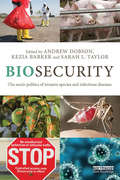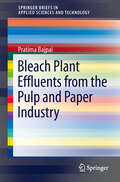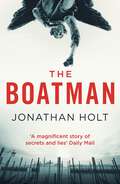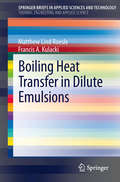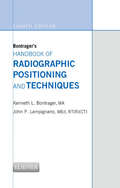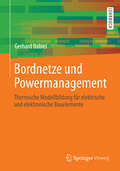- Table View
- List View
Biosecurity: Understanding, Assessing, and Preventing the Threat
by Ryan BurnetteLearn how to assess and prevent biosecurity threats to protect public health and national security With contributions from experts in all facets of biosecurity, this book explains the fundamental elements of biosecurity as well as the related concepts of biosafety and biosurety, detailing how all three concepts fit within the framework of biodefense. Readers are then given the tools needed to assess and prevent biosecurity threats and vulnerabilities. The book explores the nature of biosecurity threats to research laboratories as well as to agriculture, food, and mass transit. Moreover, readers will learn how to apply principles of biosecurity to assess epidemics and protect public health. Biosecurity takes a detailed look at today's biosecurity policy, explaining how it is likely to evolve given current and potential threats to national security. The authors stress the importance of education and advocacy, helping readers develop effective programs to build public awareness and preparedness. The book also presents a novel tool to assess the effectiveness of laboratory biosafety and biosecurity programs. Biosecurity is divided into four parts: Part I: An Introduction to Biosecurity Part II: Elements of Biosecurity Part III: Biosecurity in Various Sectors Part IV: Biosecurity Policy, Bioterrorism, and the Future This book will instill a deep understanding of what biosecurity is and what it is not. It urges readers to think about the importance of biosecurity as it relates to national security, safety, and health. By exposing major flaws in global biosecurity thinking, Biosecurity sets forth a clear pathway to correct those errors and build stronger biosecurity programs.
Biosecurity: Understanding, Assessing, and Preventing the Threat
by Ryan BurnetteLearn how to assess and prevent biosecurity threats to protect public health and national security With contributions from experts in all facets of biosecurity, this book explains the fundamental elements of biosecurity as well as the related concepts of biosafety and biosurety, detailing how all three concepts fit within the framework of biodefense. Readers are then given the tools needed to assess and prevent biosecurity threats and vulnerabilities. The book explores the nature of biosecurity threats to research laboratories as well as to agriculture, food, and mass transit. Moreover, readers will learn how to apply principles of biosecurity to assess epidemics and protect public health. Biosecurity takes a detailed look at today's biosecurity policy, explaining how it is likely to evolve given current and potential threats to national security. The authors stress the importance of education and advocacy, helping readers develop effective programs to build public awareness and preparedness. The book also presents a novel tool to assess the effectiveness of laboratory biosafety and biosecurity programs. Biosecurity is divided into four parts: Part I: An Introduction to Biosecurity Part II: Elements of Biosecurity Part III: Biosecurity in Various Sectors Part IV: Biosecurity Policy, Bioterrorism, and the Future This book will instill a deep understanding of what biosecurity is and what it is not. It urges readers to think about the importance of biosecurity as it relates to national security, safety, and health. By exposing major flaws in global biosecurity thinking, Biosecurity sets forth a clear pathway to correct those errors and build stronger biosecurity programs.
Biosecurity: The Socio-Politics of Invasive Species and Infectious Diseases
by Andrew Dobson Kezia Barker Sarah L. TaylorBiosecurity is the assessment and management of potentially dangerous infectious diseases, quarantined pests, invasive (alien) species, living modified organisms, and biological weapons. It is a holistic concept of direct relevance to the sustainability of agriculture, food safety, and the protection of human populations (including bio-terrorism), the environment, and biodiversity. Biosecurity is a relatively new concept that has become increasingly prevalent in academic, policy and media circles, and needs a more comprehensive and inter-disciplinary approach to take into account mobility, globalisation and climate change. In this introductory volume, biosecurity is presented as a governance approach to a set of concerns that span the protection of indigenous biological organisms, agricultural systems and human health, from invasive pests and diseases. It describes the ways in which biosecurity is understood and theorized in different subject disciplines, including anthropology, political theory, ecology, geography and environmental management. It examines the different scientific and knowledge practices connected to biosecurity governance, including legal regimes, ecology, risk management and alternative knowledges. The geopolitics of biosecurity is considered in terms of health, biopolitics and trade governance at the global scale. Finally, biosecurity as an approach to actively secure the future is assessed in the context of future risk and uncertainties, such as globalization and climate change.
Biosecurity: The Socio-Politics of Invasive Species and Infectious Diseases
by Andrew Dobson Kezia Barker Sarah L. TaylorBiosecurity is the assessment and management of potentially dangerous infectious diseases, quarantined pests, invasive (alien) species, living modified organisms, and biological weapons. It is a holistic concept of direct relevance to the sustainability of agriculture, food safety, and the protection of human populations (including bio-terrorism), the environment, and biodiversity. Biosecurity is a relatively new concept that has become increasingly prevalent in academic, policy and media circles, and needs a more comprehensive and inter-disciplinary approach to take into account mobility, globalisation and climate change. In this introductory volume, biosecurity is presented as a governance approach to a set of concerns that span the protection of indigenous biological organisms, agricultural systems and human health, from invasive pests and diseases. It describes the ways in which biosecurity is understood and theorized in different subject disciplines, including anthropology, political theory, ecology, geography and environmental management. It examines the different scientific and knowledge practices connected to biosecurity governance, including legal regimes, ecology, risk management and alternative knowledges. The geopolitics of biosecurity is considered in terms of health, biopolitics and trade governance at the global scale. Finally, biosecurity as an approach to actively secure the future is assessed in the context of future risk and uncertainties, such as globalization and climate change.
Biosensors and Invasive Monitoring in Clinical Applications (SpringerBriefs in Applied Sciences and Technology)
by Emma P. Córcoles Martyn G. BoutelleThis volume examines the advances of invasive monitoring by means of biosensors and microdialysis. Physical and physiological parameters are commonly monitored in clinical settings using invasive techniques due to their positive outcome in patients’ diagnosis and treatment. Biochemical parameters, however, still rely on off-line measurements and require large pieces of equipment. Biosensing and sampling devices present excellent capabilities for their use in continuous monitoring of patients’ biochemical parameters. However, certain issues remain to be solved in order to ensure a more widespread use of these techniques in today’s medical practices.
Biosignal Processing: Principles and Practices
by Hualou Liang Joseph D. Bronzino Donald R. PetersonWith the rise of advanced computerized data collection systems, monitoring devices, and instrumentation technologies, large and complex datasets accrue as an inevitable part of biomedical enterprise. The availability of these massive amounts of data offers unprecedented opportunities to advance our understanding of underlying biological and physiol
Biosignal Processing: Principles and Practices
by Hualou Liang Joseph D. Bronzino Donald R. PetersonWith the rise of advanced computerized data collection systems, monitoring devices, and instrumentation technologies, large and complex datasets accrue as an inevitable part of biomedical enterprise. The availability of these massive amounts of data offers unprecedented opportunities to advance our understanding of underlying biological and physiol
Biotechnology for Environmental Management and Resource Recovery
by Ramesh Chander Kuhad and Ajay SinghVarious types of secondary agriculture and forestry wastes represent valuable resource materials for developing alternate energy as biofuels and other value added products such as sugars, phenols, furans, organic acids, enzymes and digestible animal feed etc. However, if not managed properly, waste material and environmental contaminants generated by various industries such as food and feed, pulp and paper and textile may lead to severe environmental pollution. The energy, food and feed demand necessitate developing simple and economically viable technologies for environmental management and resource recovery. Microorganisms and their enzymes contribute significantly in utilization of plant residues, resource recovery and eventually in pollution mitigation. “Biotechnology for Environmental Management and Resource Recovery” presents a comprehensive review of selected research topics in a compendium of 16 chapters related to environmental pollution control and developing biotechnologies in agro-ecosystem management and bioconversion of agro-residues (lignocellulosics) into biofuels, animal feed and paper etc. This book provides a valuable resource for reference and text material to graduate and postgraduate students, researchers, scientists working in the area of microbiology, biotechnology, and environmental science and engineering.
Bismuth-Containing Compounds (Springer Series in Materials Science #186)
by Handong Li and Zhiming M. WangBismuth-containing compounds comprise a relatively unexplored materials system that is expected to offer many unique and desirable optoelectronic, thermoelectric, and electronic properties for innovative device applications. This book serves as a platform for knowledge sharing and dissemination of the latest advances in novel areas of bismuth-containing compounds for materials and devices, and provides a comprehensive introduction to those new to this growing field. Coverage of bismides includes theoretical considerations, epitaxial growth, characterization, and materials properties (optical, electrical, and structural). In addition to the well-studied area of highly mismatched Bi-alloys, the book covers emerging topics such as topological insulators and ferroelectric materials. Built upon fundamental science, the book is intended to stimulate interest in developing new classes of semiconductor and thermoelectric materials that exploit the properties of Bismuth. Application areas for bismide materials include laser diodes for optical communications, DVD systems, light-emitting diodes, solar cells, transistors, quantum well lasers, and spintronic devices.
Bistatic SAR Data Processing Algorithms
by Xiaolan Qiu Chibiao Ding Donghui HuSynthetic Aperture Radar (SAR) is critical for remote sensing. It works day and night, in good weather or bad. Bistatic SAR is a new kind of SAR system, where the transmitter and receiver are placed on two separate platforms. Bistatic SAR is one of the most important trends in SAR development, as the technology renders SAR more flexible and safer when used in military environments. Imaging is one of the most difficult and important aspects of bistatic SAR data processing. Although traditional SAR signal processing is fully developed, bistatic SAR has a more complex system structure, so signal processing is more challenging. Focusing on imaging aspects of bistatic SAR signal processing, this book covers resolution analysis, echo generation methods, imaging algorithms, imaging parameter estimation, and motion compensation methods. The book is ideal for researchers and engineers in SAR signal and data processing, as well as those working in bistatic and multistatic radar imaging, and in the radar sciences. Graduate students with a background in radar who are interested in bistatic and multistatic radar will find this book a helpful reference. Gives a general and updated framework for image formation using signal processing aspects Starts with an introduction to traditional SAR before moving on to more advanced topics Offers readers a range of exhaustive tools to process signals and form images Provides a solid reference for the imaging of other complicated SAR Sample image synthesis exercises are available from the book's companion site
Bistatic SAR Data Processing Algorithms
by Xiaolan Qiu Chibiao Ding Donghui HuSynthetic Aperture Radar (SAR) is critical for remote sensing. It works day and night, in good weather or bad. Bistatic SAR is a new kind of SAR system, where the transmitter and receiver are placed on two separate platforms. Bistatic SAR is one of the most important trends in SAR development, as the technology renders SAR more flexible and safer when used in military environments. Imaging is one of the most difficult and important aspects of bistatic SAR data processing. Although traditional SAR signal processing is fully developed, bistatic SAR has a more complex system structure, so signal processing is more challenging. Focusing on imaging aspects of bistatic SAR signal processing, this book covers resolution analysis, echo generation methods, imaging algorithms, imaging parameter estimation, and motion compensation methods. The book is ideal for researchers and engineers in SAR signal and data processing, as well as those working in bistatic and multistatic radar imaging, and in the radar sciences. Graduate students with a background in radar who are interested in bistatic and multistatic radar will find this book a helpful reference. Gives a general and updated framework for image formation using signal processing aspects Starts with an introduction to traditional SAR before moving on to more advanced topics Offers readers a range of exhaustive tools to process signals and form images Provides a solid reference for the imaging of other complicated SAR Sample image synthesis exercises are available from the book's companion site
Black Sea Energy Resource Development and Hydrogen Energy Problems (NATO Science for Peace and Security Series C: Environmental Security)
by Ayfer Veziroğlu and Marat TsitskishviliNATO Advanced Research Workshop “The Black Sea: Strategy for Addressing its Energy Resource Development and Hydrogen Energy Problems” was held in order to evaluate the Black Sea Region’s environment, discuss the ways and means of protecting it, and to evaluate the methods of production of the energy carrier, hydrogen. Papers presented at the workshop, proposed various methods of hydrogen production from the hydrogen sulfide, from marine macro algae and other bacteria, storage and utilization of hydrogen, oil spills and pollutants in the Black Sea, degradation of the sea and the land around the region, and ways and means of protecting the environment.The workshop participants unanimously expressed the need to establish close cooperation amongst the Region’s countries regarding the development of its energy resources, and at the same time protecting its environment. These recommendations have been put together in the Batumi Manifesto.This book entitled “Black Sea Energy Resource Development and Hydrogen Energy Problems” puts together the papers presented at the workshop, starting with the Batumi Manifesto. This valuable volume should be in the libraries of all the scientists, engineers, environmentalists, economists and decision makers involved in the development of the Black Sea Region and in the introduction of clean and abundant Hydrogen Energy.
Bleach Plant Effluents from the Pulp and Paper Industry (SpringerBriefs in Applied Sciences and Technology)
by Pratima BajpaiThis book covers bleach plant effluents, that most polluting effluent from the pulp and paper industry. Disappearance of benthic invertebrates, a high incidence of fish diseases, and mutagenic effects on the aquatic fauna are some of the consequences of the disposal of bleach effluents into surface waters. This book describes environmental impact of bleach plant effluents, environmental regulations, and measures to reduce the pollution load by internal process modification and external treatment of bleach plant effluents.
Blechmodellierung mit CATIA V5: Effizientes Konstruieren von Blechbiegeteilen
by Thomas EiblBlechbiegeteile spielen im Maschinenbau aber auch im Alltag eine wichtige Rolle. Die Arbeitsumgebung Sheetmetal Design in CATIA V5 ist eine erweiterte Konstruktionsumgebung für das Konstruieren von Blechbiegeteilen und baut auf dem Part Design auf. Diese Schritt-für-Schritt-Anleitung zeigt sehr anschaulich das effiziente Konstruieren von einfachen bis zu komplexen Blechbiegeteilen und gerollten Blechteilen. Die Beschreibung der Basismethoden und der Konstruktionsmethodik sowie der Konstruktionsreihenfolge stehen im Vordergrund dieses Lehrbuches. Das Buch richtet sich an Studenten des Maschinenbaus an technischen Universitäten und Fachhochschulen sowie höheren technischen Lehranstalten und Fachschulen; ebenso an Ingenieure und Techniker sowie Teilnehmer von Weiterbildungskursen, die sich mit Fragestellungen der Blechmodellierung mit CATIA V5 beschäftigen.
Blind Identification and Separation of Complex-valued Signals
by Eric Moreau Tülay AdaliBlind identification consists of estimating a multi-dimensional system only through the use of its output, and source separation, the blind estimation of the inverse of the system. Estimation is generally carried out using different statistics of the output. The authors of this book consider the blind identification and source separation problem in the complex-domain, where the available statistical properties are richer and include non-circularity of the sources – underlying components. They define identifiability conditions and present state-of-the-art algorithms that are based on algebraic methods as well as iterative algorithms based on maximum likelihood theory. Contents 1. Mathematical Preliminaries. 2. Estimation by Joint Diagonalization. 3. Maximum Likelihood ICA. About the Authors Eric Moreau is Professor of Electrical Engineering at the University of Toulon, France. His research interests concern statistical signal processing, high order statistics and matrix/tensor decompositions with applications to data analysis, telecommunications and radar. Tülay Adali is Professor of Electrical Engineering and Director of the Machine Learning for Signal Processing Laboratory at the University of Maryland, Baltimore County, USA. Her research interests concern statistical and adaptive signal processing, with an emphasis on nonlinear and complex-valued signal processing, and applications in biomedical data analysis and communications. Blind identification consists of estimating a multidimensional system through the use of only its output. Source separation is concerned with the blind estimation of the inverse of the system. The estimation is generally performed by using different statistics of the outputs. The authors consider the blind estimation of a multiple input/multiple output (MIMO) system that mixes a number of underlying signals of interest called sources. They also consider the case of direct estimation of the inverse system for the purpose of source separation. They then describe the estimation theory associated with the identifiability conditions and dedicated algebraic algorithms. The algorithms depend critically on (statistical and/or time frequency) properties of complex sources that will be precisely described.
Blind Identification and Separation of Complex-valued Signals
by Eric Moreau Tülay AdaliBlind identification consists of estimating a multi-dimensional system only through the use of its output, and source separation, the blind estimation of the inverse of the system. Estimation is generally carried out using different statistics of the output. The authors of this book consider the blind identification and source separation problem in the complex-domain, where the available statistical properties are richer and include non-circularity of the sources – underlying components. They define identifiability conditions and present state-of-the-art algorithms that are based on algebraic methods as well as iterative algorithms based on maximum likelihood theory. Contents 1. Mathematical Preliminaries. 2. Estimation by Joint Diagonalization. 3. Maximum Likelihood ICA. About the Authors Eric Moreau is Professor of Electrical Engineering at the University of Toulon, France. His research interests concern statistical signal processing, high order statistics and matrix/tensor decompositions with applications to data analysis, telecommunications and radar. Tülay Adali is Professor of Electrical Engineering and Director of the Machine Learning for Signal Processing Laboratory at the University of Maryland, Baltimore County, USA. Her research interests concern statistical and adaptive signal processing, with an emphasis on nonlinear and complex-valued signal processing, and applications in biomedical data analysis and communications. Blind identification consists of estimating a multidimensional system through the use of only its output. Source separation is concerned with the blind estimation of the inverse of the system. The estimation is generally performed by using different statistics of the outputs. The authors consider the blind estimation of a multiple input/multiple output (MIMO) system that mixes a number of underlying signals of interest called sources. They also consider the case of direct estimation of the inverse system for the purpose of source separation. They then describe the estimation theory associated with the identifiability conditions and dedicated algebraic algorithms. The algorithms depend critically on (statistical and/or time frequency) properties of complex sources that will be precisely described.
Blind Source Separation: Theory and Applications
by Xianchuan Yu Dan Hu Jindong XuA systematic exploration of both classic and contemporary algorithms in blind source separation with practical case studies The book presents an overview of Blind Source Separation, a relatively new signal processing method. Due to the multidisciplinary nature of the subject, the book has been written so as to appeal to an audience from very different backgrounds. Basic mathematical skills (e.g. on matrix algebra and foundations of probability theory) are essential in order to understand the algorithms, although the book is written in an introductory, accessible style. This book offers a general overview of the basics of Blind Source Separation, important solutions and algorithms, and in-depth coverage of applications in image feature extraction, remote sensing image fusion, mixed-pixel decomposition of SAR images, image object recognition fMRI medical image processing, geochemical and geophysical data mining, mineral resources prediction and geoanomalies information recognition. Firstly, the background and theory basics of blind source separation are introduced, which provides the foundation for the following work. Matrix operation, foundations of probability theory and information theory basics are included here. There follows the fundamental mathematical model and fairly new but relatively established blind source separation algorithms, such as Independent Component Analysis (ICA) and its improved algorithms (Fast ICA, Maximum Likelihood ICA, Overcomplete ICA, Kernel ICA, Flexible ICA, Non-negative ICA, Constrained ICA, Optimised ICA). The last part of the book considers the very recent algorithms in BSS e.g. Sparse Component Analysis (SCA) and Non-negative Matrix Factorization (NMF). Meanwhile, in-depth cases are presented for each algorithm in order to help the reader understand the algorithm and its application field. A systematic exploration of both classic and contemporary algorithms in blind source separation with practical case studies Presents new improved algorithms aimed at different applications, such as image feature extraction, remote sensing image fusion, mixed-pixel decomposition of SAR images, image object recognition, and MRI medical image processing With applications in geochemical and geophysical data mining, mineral resources prediction and geoanomalies information recognition Written by an expert team with accredited innovations in blind source separation and its applications in natural science Accompanying website includes a software system providing codes for most of the algorithms mentioned in the book, enhancing the learning experience Essential reading for postgraduate students and researchers engaged in the area of signal processing, data mining, image processing and recognition, information, geosciences, life sciences.
Blind Source Separation: Theory and Applications
by Xianchuan Yu Dan Hu Jindong XuA systematic exploration of both classic and contemporary algorithms in blind source separation with practical case studies The book presents an overview of Blind Source Separation, a relatively new signal processing method. Due to the multidisciplinary nature of the subject, the book has been written so as to appeal to an audience from very different backgrounds. Basic mathematical skills (e.g. on matrix algebra and foundations of probability theory) are essential in order to understand the algorithms, although the book is written in an introductory, accessible style. This book offers a general overview of the basics of Blind Source Separation, important solutions and algorithms, and in-depth coverage of applications in image feature extraction, remote sensing image fusion, mixed-pixel decomposition of SAR images, image object recognition fMRI medical image processing, geochemical and geophysical data mining, mineral resources prediction and geoanomalies information recognition. Firstly, the background and theory basics of blind source separation are introduced, which provides the foundation for the following work. Matrix operation, foundations of probability theory and information theory basics are included here. There follows the fundamental mathematical model and fairly new but relatively established blind source separation algorithms, such as Independent Component Analysis (ICA) and its improved algorithms (Fast ICA, Maximum Likelihood ICA, Overcomplete ICA, Kernel ICA, Flexible ICA, Non-negative ICA, Constrained ICA, Optimised ICA). The last part of the book considers the very recent algorithms in BSS e.g. Sparse Component Analysis (SCA) and Non-negative Matrix Factorization (NMF). Meanwhile, in-depth cases are presented for each algorithm in order to help the reader understand the algorithm and its application field. A systematic exploration of both classic and contemporary algorithms in blind source separation with practical case studies Presents new improved algorithms aimed at different applications, such as image feature extraction, remote sensing image fusion, mixed-pixel decomposition of SAR images, image object recognition, and MRI medical image processing With applications in geochemical and geophysical data mining, mineral resources prediction and geoanomalies information recognition Written by an expert team with accredited innovations in blind source separation and its applications in natural science Accompanying website includes a software system providing codes for most of the algorithms mentioned in the book, enhancing the learning experience Essential reading for postgraduate students and researchers engaged in the area of signal processing, data mining, image processing and recognition, information, geosciences, life sciences.
Bluetooth Security Attacks: Comparative Analysis, Attacks, and Countermeasures (SpringerBriefs in Computer Science)
by Keijo Haataja Konstantin Hyppönen Sanna Pasanen Pekka ToivanenBluetooth technology has enjoyed tremendous success, and it's now employed in billions of devices for short-range wireless data and real-time audio or video transfer. In this book the authors provide an overview of Bluetooth security. They examine network vulnerabilities and provide a literature-review comparative analysis of recent security attacks. They analyze and explain related countermeasures, including one based on secure simple pairing, and they also propose a novel attack that works against all existing Bluetooth versions. They conclude with a discussion on future research directions. The book is appropriate for practitioners and researchers in information security, in particular those engaged in the design of networked and mobile devices.
The Boatman (The Carnivia Trilogy #1)
by Jonathan HoltA superb conspiracy thriller set in Venice, from a Sunday Times bestseller. ********They found the woman's body on the steps of a church, washed up by Venice's winter tides. A tattoo on her wrist matched graffiti in an abandoned hospital, not used since the Second World War. It's Captain Kat Tapo's first murder case, and she'll do anything to get to the truth. But as the hunt for the killer intensifies, she discovers secrets from Italy's dark wartime past that will put her in great danger... This is the first novel in a trilogy of stylish and intelligent thrillers set in Venice from Jonathan Holt who, under the name J.P. Delaney, is also the author of the Sunday Times bestselling psychological thrillers The Girl Before and The Perfect Wife. Previously published as The Abomination. ********Reviews for The Carnivia Trilogy: 'Genuinely thrilling... An illuminating portrait of a particular world' Literary Review. 'Tense and mind-bending' Daily Telegraph. 'Breathtaking... A truly haunting glimpse into a mysterious shadow world' New York Times. 'Impressive... Venice is a magnificent backdrop for a story of secrets and lies' Daily Mail. 'A cracking, upmarket thriller... A rare entertainment for the thinking deckchair reader'Saga Magazine. What readers are saying about The Carnivia Trilogy: 'Superb – an exciting tale involving people smuggling, the Catholic Church and US intelligence operatives... A compelling story which will appeal to readers who enjoy a mix of conspiracy theory and cover-up' Amazon Reader. 'An unravelling of several interconnected plot strands with action and twists that never stop, but at a deeper level Holt also engages with human rights and gender issues... This is a "can't put it down" novel' Amazon Reader. 'The detailed reconstruction of the setting in Venice is fabulous and is equalled both by characterisation and plot... Gripping and thrilling... and distressingly possible' Amazon Reader. 'Fabulously descriptive, intriguing, fast paced... A must-read for anyone who enjoys a good thriller that is well researched and excellently written' Amazon Reader. 'Fast paced, good characters and interesting mix of plot strands. Each book in the trilogy can be read as a stand alone, but reading all of them rounds off the story strands nicely' Amazon Reader.
Boiling Heat Transfer in Dilute Emulsions (SpringerBriefs in Applied Sciences and Technology)
by Matthew Lind Roesle Francis A. KulackiBoiling Heat Transfer in Dilute Emulsions synthesizes recent advances and established understanding on the subject of boiling in dilute emulsions. Experimental results from various sources are collected and analyzed, including contemporary experiments that correlate visualization with heat transfer data. Published models of boiling heat transfer in dilute emulsions, and their implementation, are described and assessed against experimental data.
Bontrager's Handbook of Radiographic Positioning and Techniques - E-BOOK
by Kenneth L. Bontrager John Lampignano"The various components contained in this handbook are presented in seamless combination and with a clarity becoming of a much larger work. The book is worthy of recommendation for all those interested in the strenghtening and honing of their core radiographic skills." Reviewed by: RAD Magazine, Barry K Denton, acting radiology services manager, Hywel Dda University Health Board, Wales Date: July 2014
Boolean Differential Equations (Synthesis Lectures on Digital Circuits & Systems)
by Bernd Steinbach Christian PosthoffThe Boolean Differential Calculus (BDC) is a very powerful theory that extends the structure of a Boolean Algebra significantly. Based on a small number of definitions, many theorems have been proven. The available operations have been efficiently implemented in several software packages. There is a very wide field of applications. While a Boolean Algebra is focused on values of logic functions, the BDC allows the evaluation of changes of function values. Such changes can be explored for pairs of function values as well as for whole subspaces. Due to the same basic data structures, the BDC can be applied to any task described by logic functions and equations together with the Boolean Algebra. The BDC can be widely used for the analysis, synthesis, and testing of digital circuits. Generally speaking, a Boolean differential equation (BDE) is an equation in which elements of the BDC appear. It includes variables, functions, and derivative operations of these functions. The solution of such a BDE is a set of Boolean functions. This is a significant extension of Boolean equations, which have sets of Boolean vectors as solutions. In the simplest BDE a derivative operation of the BDC on the left-hand side is equal to a logic function on the right-hand side. The solution of such a simple BDE means to execute an operation which is inverse to the given derivative. BDEs can be applied in the same fields as the BDC, however, their possibility to express sets of Boolean functions extends the application field significantly.
Bordnetze und Powermanagement: Thermische Modellbildung für elektrische und elektronische Bauelemente
by Gerhard BabielIn einem modernen Fahrzeug sind einige hundert Meter an Leitungen und Kabel verlegt. Einige tausend Kontaktstellen sind erforderlich, um die elektrischen Funktionen sicherzustellen. Mit jedem neuen elektronischen Produkt im KFZ wächst auch das Bordnetz an und erfordert immer höhere Anstrengungen zur Sicherheit und Zuverlässigkeit im Powermanagement. In diesem Buch findet sich neben den aus der Elektrotechnik und Werkstoffkunde bekannten Grundlagen auch ein spezielleres Kapitel (Kap. 5) zur wärmetechnischen Auslegung von Leitungen und Bordnetzkomponenten. Das theoretische Fundament dieses Kapitels wird durch einige Sätze aus der Differentialgeometrie und der Signaltheorie gelegt. Es wird aber auch Wert darauf gelegt, die Erkenntnisse für den Entwickler anzuwenden. Der Praxisbezug wird auch durch Übungs- bzw. Klausuraufgaben aus der Vorlesung „Bordnetze und Leistungshalbleiter“ untermauert.
Bounded Noises in Physics, Biology, and Engineering (Modeling and Simulation in Science, Engineering and Technology)
by Alberto D'OnofrioSince the parameters in dynamical systems of biological interest are inherently positive and bounded, bounded noises are a natural way to model the realistic stochastic fluctuations of a biological system that are caused by its interaction with the external world. Bounded Noises in Physics, Biology, and Engineering is the first contributed volume devoted to the modeling of bounded noises in theoretical and applied statistical mechanics, quantitative biology, and mathematical physics. It gives an overview of the current state-of-the-art and is intended to stimulate further research. The volume is organized in four parts. The first part presents the main kinds of bounded noises and their applications in theoretical physics. The theory of bounded stochastic processes is intimately linked to its applications to mathematical and statistical physics, and it would be difficult and unnatural to separate the theory from its physical applications. The second is devoted to framing bounded noises in the theory of random dynamical systems and random bifurcations, while the third is devoted to applications of bounded stochastic processes in biology, one of the major areas of potential applications of this subject. The final part concerns the application of bounded stochastic processes in mechanical and structural engineering, the area where the renewed interest for non-Gaussian bounded noises started. Pure mathematicians working on stochastic calculus will find here a rich source of problems that are challenging from the point of view of contemporary nonlinear analysis. Bounded Noises in Physics, Biology, and Engineering is intended for scientists working on stochastic processes with an interest in both fundamental issues and applications. It will appeal to a broad range of applied mathematicians, mathematical biologists, physicists, engineers, and researchers in other fields interested in complexity theory. It is accessible to anyone with a working knowledge of stochastic modeling, from advanced undergraduates to senior researchers.

